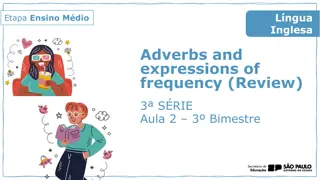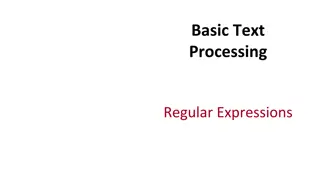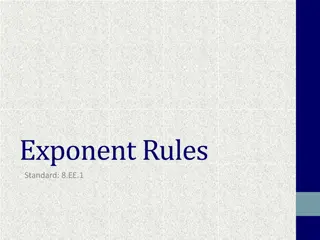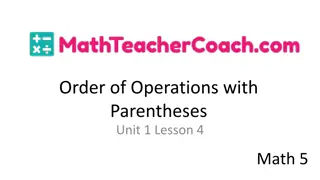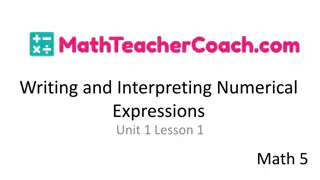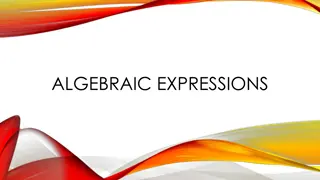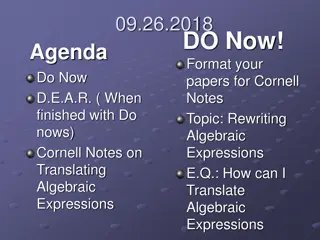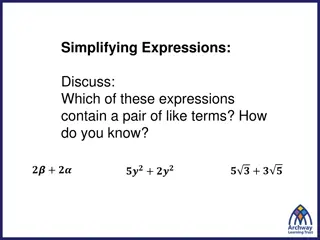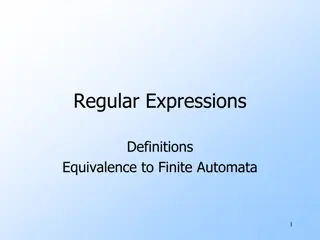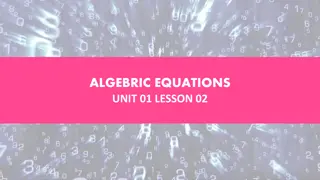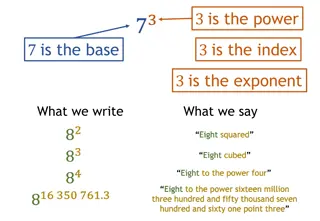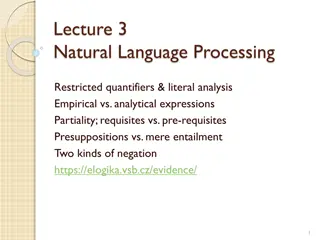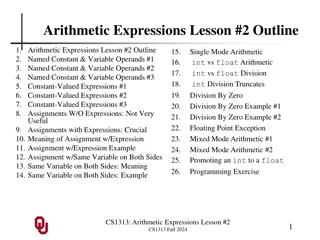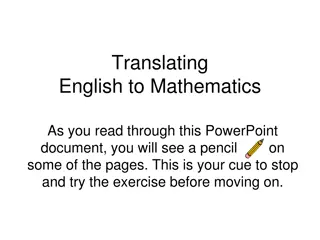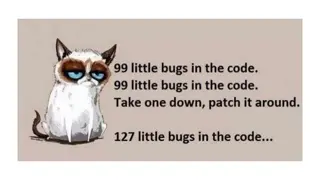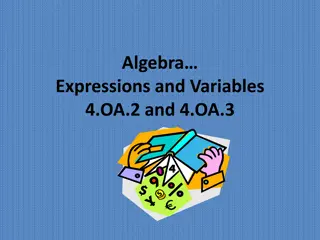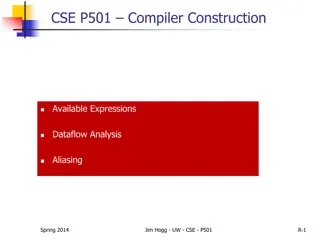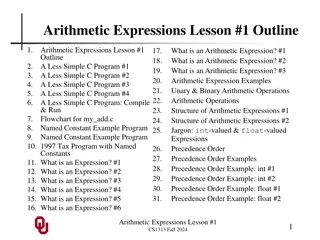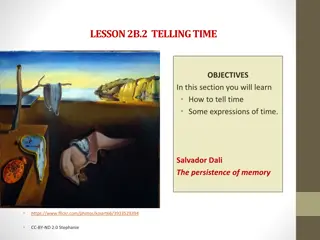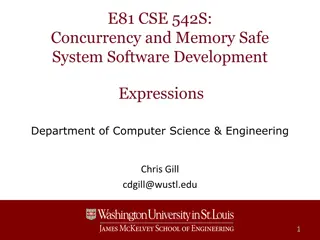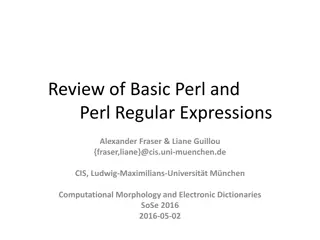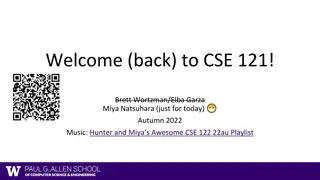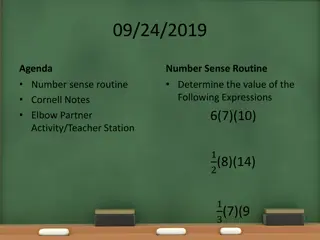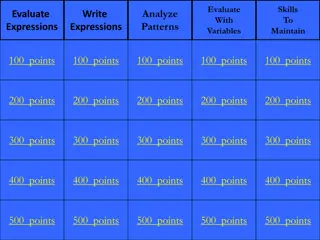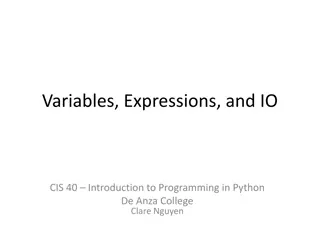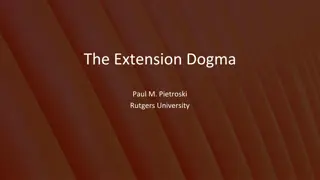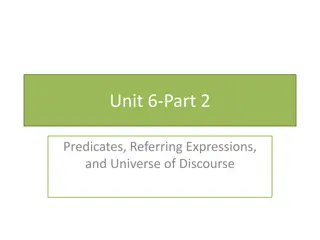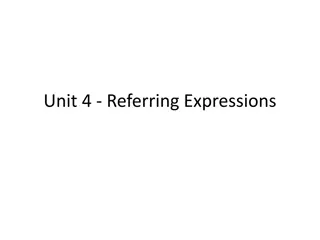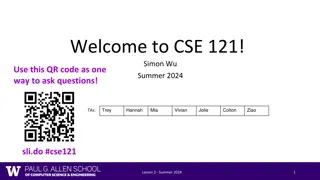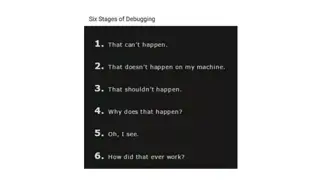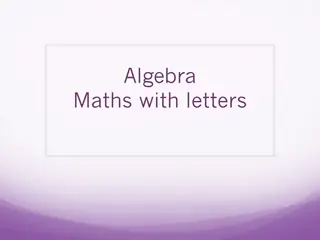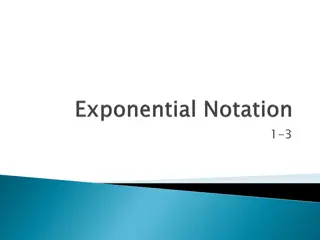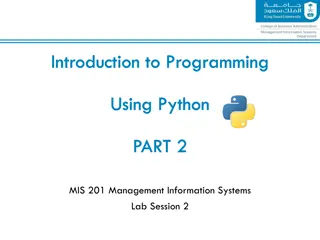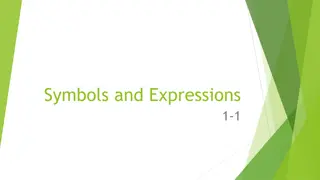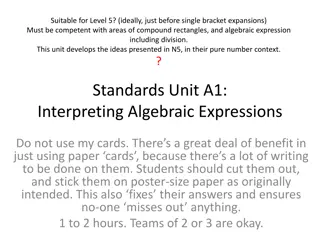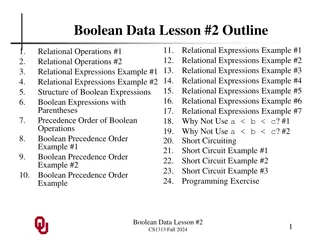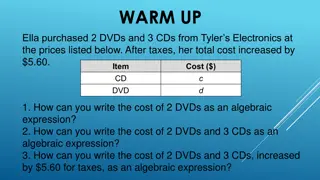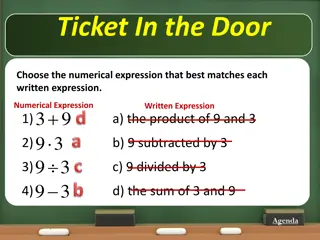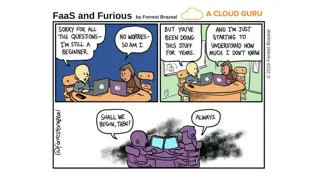Adverbs and Expressions of Frequency in English
Reviewing adverbs and expressions of frequency in English language for oral and written text production. Focus on types of relationships and grammar. Activities to analyze sentences and frequency indicators. Overview of common adverbs and expressions used to express regularity.
5 views • 20 slides
Regular Expressions for Text Processing
Regular expressions provide a powerful way to search for and manipulate text strings by specifying patterns. This content explores different aspects of regular expressions, including disjunctions, negations, more disjunctions, optional characters, anchors, and examples. By learning how to use regula
2 views • 46 slides
Exponents and Rules
Exponents are a shortcut for repeated multiplication. Learn how to write expressions using exponents, evaluate expressions containing exponents, and apply rules for dealing with exponents. Explore examples and see how to write expressions in exponential form, evaluate them using calculators, and sim
2 views • 32 slides
Order of Operations with Parentheses
Explore the importance of grouping symbols in numerical expressions with parentheses, brackets, and braces. Learn how to identify and evaluate expressions following the PEMDAS rule and the funnel method. Master key vocabulary and solve problems involving order of operations in mathematical expressio
1 views • 41 slides
Numerical Expressions in Mathematics
Explore the concept of numerical expressions in math, focusing on recognizing, writing, and interpreting expressions involving addition, subtraction, multiplication, and division. Learn key vocabulary and solve sample problems to enhance comprehension.
1 views • 36 slides
Algebraic Expressions: Variables, Coefficients, and Constants
Explore the difference between numeric and algebraic expressions, learn about the components of algebraic expressions - variables, coefficients, and constants. Discover how to identify variables, coefficients, and constants in expressions. Classify algebraic expressions as monomials, binomials, or t
0 views • 20 slides
Mastering Algebraic Expressions: Translating Words to Equations
Learn how to translate word phrases into algebraic expressions for addition, subtraction, multiplication, and division. Understand the key phrases associated with each operation to write expressions accurately. Enhance your skills in rewriting algebraic expressions with practical examples and concis
4 views • 17 slides
Introduction to Perl Regular Expressions in SAS
Regular expressions are powerful tools for working with unstructured data in SAS, allowing you to search for specific patterns, extract substrings, and perform text substitutions using metacharacters in Perl. While writing regular expressions can be challenging at first, with practice, you can becom
1 views • 33 slides
Simplifying Expressions by Identifying Like Terms
This content discusses the concept of like terms in algebraic expressions and explains how to identify and simplify expressions by collecting like terms. It provides visual examples and prompts for practice to enhance understanding.
0 views • 27 slides
Equivalence of Regular Expressions and Finite Automata
Regular expressions are an algebraic method to describe languages, specifically the regular languages. They are defined recursively based on symbols and operations such as concatenation and closure. Precedence rules and examples are also provided. The equivalence between regular expressions and fini
1 views • 25 slides
Algebraic Expressions and Exponents
Master the basics of algebraic expressions, simplification, and exponent rules in this lesson. Learn to interpret word problems into algebraic expressions, apply properties of real numbers, and solve algebraic problems step by step. Practice evaluating expressions, simplifying equations, and underst
1 views • 13 slides
Numerical Expressions and Exponents Overview
This content covers various numerical expressions involving exponents, including examples of valid and invalid mathematical representations, matching worded expressions with their numerical equivalents, and identifying the correct expressions based on provided criteria.
0 views • 30 slides
Empirical vs Analytical Expressions in Natural Language Processing
Restricted quantifiers and literal analysis in natural language processing reveal the distinctions between empirical and analytical expressions. While empirical expressions refer to non-trivial intensions that require empirical investigation, analytical expressions denote constant intensions that ca
1 views • 19 slides
Arithmetic Expressions and Constants in Programming
Learn about the importance of named constants and variables in arithmetic expressions, how to perform assignments with and without expressions, and the implications of working with integer and floating-point arithmetic in programming. Explore examples and exercises to enhance your programming skills
0 views • 26 slides
Mathematical Expressions in Algebra
Explore how to translate English phrases into mathematical expressions in algebra. Learn key phrases for addition, subtraction, multiplication, and division, and practice writing expressions for various scenarios. This presentation includes examples and guidance for mastering algebraic concepts.
0 views • 31 slides
Building interactive interpreter for Calculator Language with REPL, Parsing, and Lexical Analysis
This project involves creating a user interface similar to a Read-Eval-Print Loop (REPL) for programming languages. Users can input text representations of expressions, which are then parsed, evaluated, and errors are handled accordingly before displaying the expression's value. Additionally, the st
0 views • 22 slides
Expressions and Variables in Algebra
Learn how to find a variable in an expression and solve expressions using phrases like "three more than a number" or "nine times a number." Discover how to translate words into algebraic expressions with missing variables and avoid using certain letters.
0 views • 18 slides
Dataflow Analysis for Available Expressions in Compiler Construction
Utilizing dataflow analysis techniques, the concept of available expressions is discussed in the context of compiler construction. The goal is to identify common subexpressions that span basic blocks by calculating their availability at the beginning of each block. The process involves determining w
0 views • 59 slides
Arithmetic Expressions in C Programming
This lesson outlines the basics of arithmetic expressions in C programming, focusing on how to perform unary and binary arithmetic operations. It covers the structure of arithmetic expressions, precedence order, and examples to illustrate these concepts. The provided C program, 'my_add,' demonstrate
0 views • 31 slides
Learning to Tell Time: Essential Tips and Expressions
In this section, you will learn how to tell time using expressions such as "Quelle heure est-il?" (What time is it?) and different methods for telling time based on the hour. You will also discover expressions for specific times of the day and how to differentiate between telling time and expressing
0 views • 4 slides
Rust Expressions and Declarations in System Software Development
Rust is an expression language where most things have values. Learn about Rust expressions, blocks, declarations, conditional expressions, multi-case expressions, and iteration expressions in system software development. Explore the execution semantics, syntax, and best practices for writing safe an
0 views • 8 slides
Review of Basic Perl and Perl Regular Expressions
A thorough review of Perl and Perl Regular Expressions covering topics such as the importance of regular expressions in Perl, the benefits and drawbacks of using Perl for scripting, a simple Perl example, understanding Perl syntax, and how to run a Perl program. The review emphasizes Perl's strength
0 views • 60 slides
Introduction to CSE 121: Types and Simple Expressions - Autumn 2022
Today's lesson in CSE 121 covers types and simple expressions in Java. Reviewing integers, doubles, strings, and booleans. Understanding operator precedence and practice problems. Explore how Java handles different types in expressions. Engage with TAs and classmates for assistance.
0 views • 11 slides
Algebraic Expressions Lesson Overview
This lesson focuses on writing and reading algebraic and written expressions with grouping symbols and less than. Students will learn how to translate expressions containing groupings and less than. The lesson is designed to build on the previous day's lesson and challenge students' thinking. It set
0 views • 25 slides
Expressions and Patterns Evaluation Practice
The content focuses on evaluating expressions with variables, analyzing patterns, and maintaining mathematical skills. It includes practice exercises such as inserting parentheses to alter expression values and identifying errors in calculations. Additionally, it presents scenarios where individuals
0 views • 53 slides
Introduction to Variables, Expressions, and I/O in Python
Dive into the basics of Python programming with a focus on variables, expressions, and input/output operations. Learn about arithmetic operators, order of operations, and data types such as integers, floats, and strings. Understand how Python interprets mathematical expressions and interacts with us
0 views • 25 slides
The Extension Dogma: Exploring Meaning and Extensions in Linguistic Expressions
The Extension Dogma challenges the assumption that linguistic expressions inherently possess meanings. Instead, it posits that expressions have extensions without necessary meanings that determine them. Theories of meaning should focus on the extensions of expressions, while psychological studies of
0 views • 30 slides
Language and Fiction: Predicates, Referring Expressions, Unreal Worlds
Explore the concepts of predicates, referring expressions, and unreal worlds in language. Understand generic sentences, imaginary creatures, and the use of language to talk about non-existent things. Delve into the broad interpretation of referring expressions and the possibility of using them in ut
0 views • 15 slides
Referring Expressions in Linguistics
Explore the concept of referring expressions in linguistics with examples, quick quizzes, and explanations. Learn about expressions with variable and constant references, differences in referents, expressions with no reference, and the definition of reference. Discover how linguistic context plays a
0 views • 10 slides
Data Types, Expressions, and Operators in Java
This resource provides information on data types, expressions, and operators in Java. It covers topics such as data types (int, double, String, boolean), operator precedence, and practice problems to work on expressions and types. The content includes announcements, reminders, a recap of data types,
0 views • 20 slides
Declarative Programming and Regular Expressions
Declarative programming emphasizes describing the desired result rather than the computational processes, leading to domain-specific languages designed for specific problem domains. Regular expressions offer powerful pattern matching capabilities facilitating tasks such as parsing, querying database
0 views • 28 slides
Algebraic Expressions: From Words to Equations
Explore the world of algebra through letters and expressions. Learn to translate words into mathematical equations, solve for variables, and manipulate algebraic expressions. From adding and subtracting paperclips to mastering BIDMAS, this lesson will deepen your understanding of algebra concepts.
0 views • 21 slides
Exponential Notation and Evaluating Expressions with Exponents
Learn about the vocabulary related to exponential notation, how to write expressions with exponents, and how to evaluate expressions with exponents both inside and outside parentheses. Practice problems included to enhance understanding.
0 views • 17 slides
Python Programming Essentials: Basics, Operators, Expressions, and Control Flow
This segment delves into the fundamentals of Python programming with a focus on essential concepts such as comments, numbers, strings, variables, arithmetic operators, logical operators, order of execution, expressions, and control flow statements like conditional execution and looping. Learn about
0 views • 12 slides
Algebraic Expressions and Operations
Introduction to algebraic expressions, variables, order of operations, and evaluating expressions. Learn about natural numbers, whole numbers, and rational numbers. Examples and explanations provided to help you grasp essential concepts in algebra.
0 views • 7 slides
Developing Algebraic Expressions: Level 5 Mastery Unit
Explore the concepts of compound rectangles, algebraic expressions, and division at a Level 5 standard just before single bracket expansions. This unit focuses on interpreting algebraic expressions through hands-on activities involving cutting out and arranging cards on large posters. Students work
0 views • 30 slides
Relational Operations for Boolean Expressions
Learn about relational operations in Boolean expressions through examples and explanations. Discover how to compare numeric operands to produce Boolean results, covering equal to, not equal to, less than, less than or equal to, greater than, and greater than or equal to operations. The content inclu
0 views • 25 slides
Algebraic Expressions: Terms, Factors, and Coefficients
When dealing with algebraic expressions, it's essential to grasp terms, factors, and coefficients. Expressions consist of numbers, operations, and variables, with terms being the building blocks separated by addition or subtraction signs. Factors are the components of each term that produce the give
0 views • 13 slides
Math Expressions Exploration for Elementary Students
This content discusses numerical and algebraic expressions, teaching students how to match written expressions to numerical expressions, understand the concept of variables, and differentiate between algebraic and numerical expressions. It also covers basic operations like addition, subtraction, mul
0 views • 11 slides
Basic Python Syntax and Expressions
Python programs manipulate values using expressions and statements. Programs work by evaluating expressions that result in values. The interpreter processes expressions to display their values, while statements direct the flow of the program. Python supports different data types such as integers, fl
0 views • 46 slides
